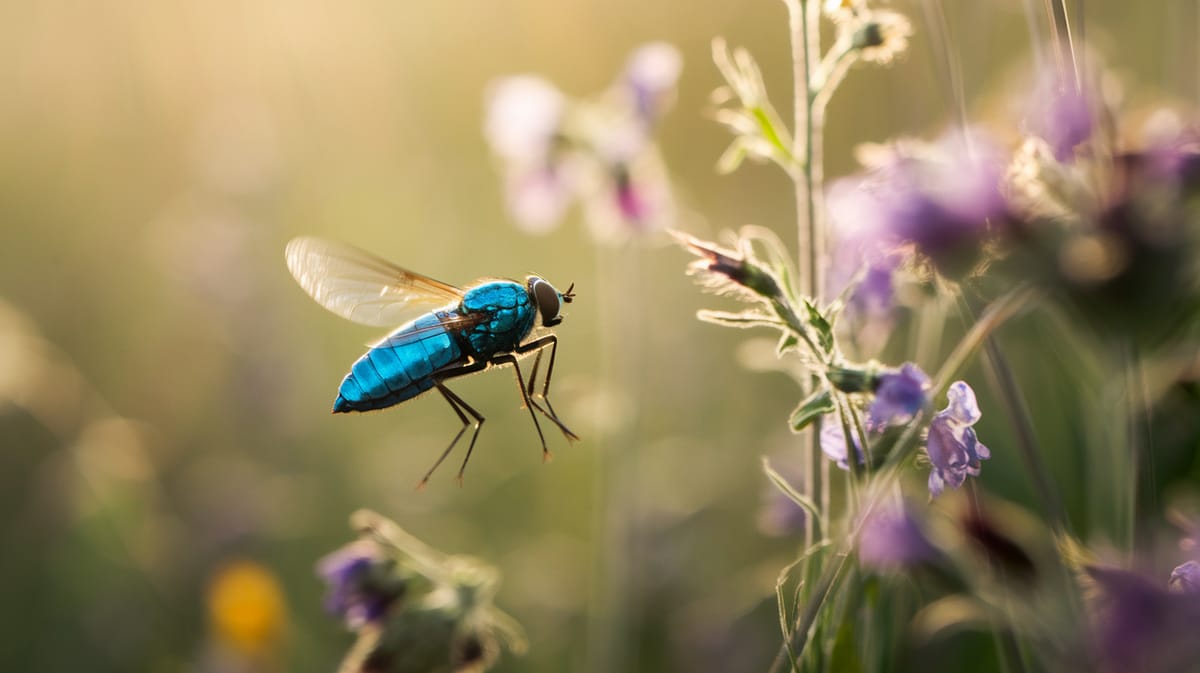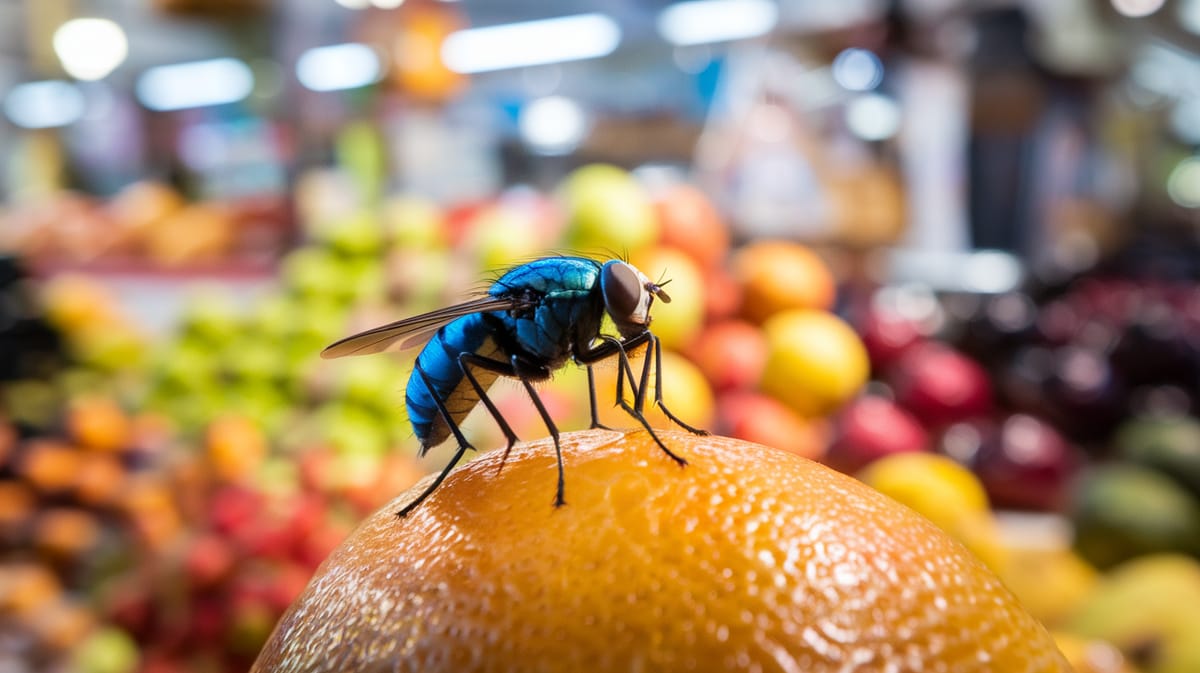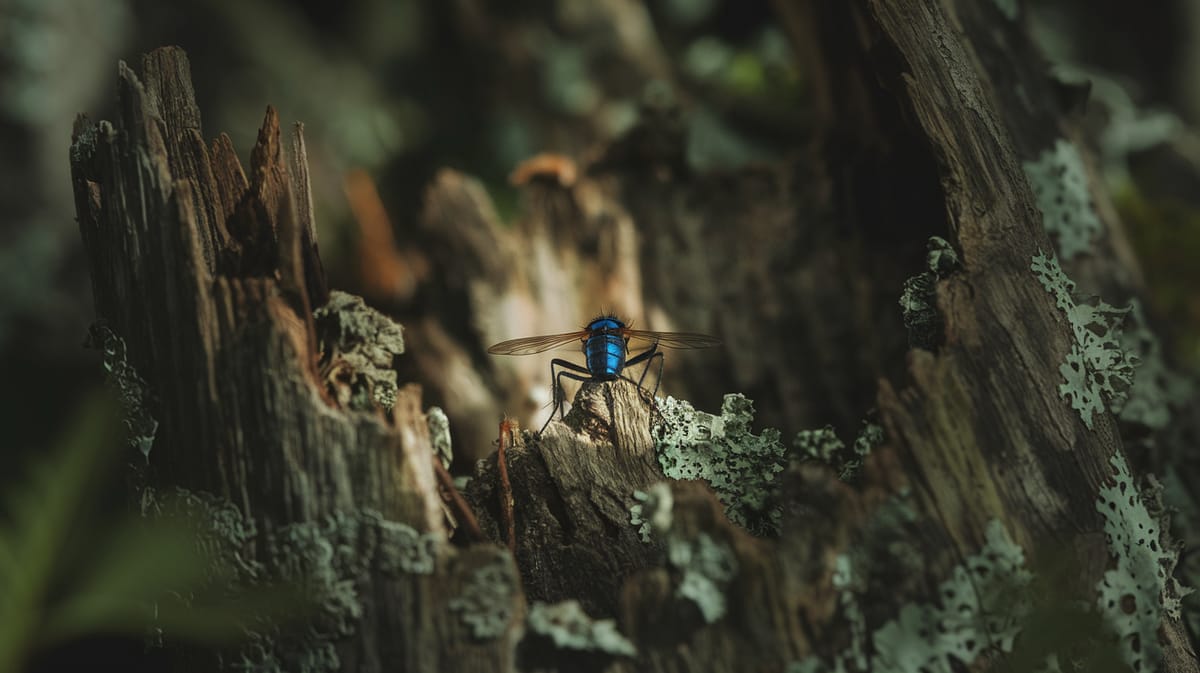Blue Bottle Fly
With striking metallic blue hues, the Blue Bottle Fly is a vital decomposer, breaking down organic matter in ecosystems. Its buzzing flight is a familiar sound worldwide.

Key Insights at a Glance
Did You Know?
Taxonomy & Classification
Blue Bottle Flies are known for their iridescent blue bodies and rapid reproductive cycles, playing a crucial role in decomposition and forensic science. Let's understand the evolutionary journey and classification of these remarkable decomposers.
Global Presence
Calliphora genus includes numerous species widely distributed across temperate regions, with Calliphora vomitoria being a common representative in Europe and North America.
Evolutionary Adaptations
Emerging around 65 million years ago, Blue Bottle Flies developed effective sensory adaptations for locating carrion, aiding their survival through major ecological shifts.
Lifecycle and Growth
A remarkable journey of transformation from Egg to Adult.
Egg
Eggs hatch into larvae, laid in clusters on decaying organic matter, ensuring a nutrient-rich environment for development.
Larva
Larvae, or maggots, feed voraciously on decaying matter, growing rapidly and shedding their skins multiple times.
Pupa
The larva transforms inside a protective casing, undergoing metamorphosis to emerge as a fully developed adult fly.
Adult
Adults are equipped with iridescent blue bodies, primarily focusing on reproduction and dispersal to new breeding sites.
Dietary Habits
A scavenger with a preference for decaying matter, this insect efficiently consumes organic waste and helps recycle nutrients in ecosystems.
| DIET TYPE | DESCRIPTION |
|---|---|
| Primary Diet | Primarily feeds on decaying animal carcasses, feces, and spoiled meat, using its sponging mouthparts to ingest liquid nutrients. |
| Secondary Diet | Consumes nectar and other sugary substances from flowers, providing a secondary energy source for its day-to-day activities. |
| Occasional | Occasionally feeds on fermenting plant materials or sugary liquids, adapting to available organic resources in its environment. |

Behaviour and Adaptations
Discover the fascinating traits that make the Blue Bottle Fly a master of survival.
Rapid Reproduction
Lays hundreds of eggs in a short span, ensuring species continuation.
Acute Smell Detection
Highly sensitive olfactory receptors locate food sources over long distances.
Efficient Decomposition
Accelerates organic matter breakdown, playing a crucial ecological role.
Ecosystem Impact
Supporting ecological balance through the unique contributions of the Blue Bottle Fly.
Decomposition Expert
Aids in breaking down organic matter, returning nutrients to the soil.
Pollination Partner
Contributes to the pollination process, supporting plant reproduction.
Food Chain Connector
Serves as a food source for birds and small mammals.
Conservation Challenges
Understanding and addressing the major threats to Blue Bottle Fly populations.
Chemical Exposure
Pesticides and industrial chemicals harm Blue Bottle Fly populations, disrupting ecological balance.
Habitat Degradation
Urbanization and pollution lead to habitat loss, threatening Blue Bottle Fly survival.
Climate Change
Altered climates affect the fly's life cycle and distribution.
Frequently Asked Questions
How long do Blue Bottle Fly live?
Blue Bottle Flies typically live for about two to four weeks. Their lifespan can vary depending on environmental conditions and availability of food sources. During this time, they go through several life stages: egg, larva, pupa, and adult.
What do Blue Bottle Fly eat?
Blue Bottle Flies feed on a variety of substances, primarily organic matter. They are often attracted to decaying meat, animal feces, and garbage. As adults, they are also known to feed on nectar and other sugary substances.
Are Blue Bottle Fly poisonous?
Blue Bottle Flies are not poisonous, but they can carry bacteria and pathogens from decaying matter to human food and surfaces, potentially causing health issues. It is important to maintain good hygiene to prevent contamination.
Are Blue Bottle Fly endangered?
Blue Bottle Flies are not considered endangered. They are common and widespread, often found in urban and rural areas across the world. Their adaptability and reproductive capacity help maintain stable populations.
What do Blue Bottle Fly symbolize?
In various cultures, Blue Bottle Flies can symbolize transformation, change, or renewal due to their life cycle. They can also be seen as symbols of annoyance because of their association with decay and their buzzing presence.
Do Blue Bottle Fly bite?
Blue Bottle Flies do not bite humans. They lack the mouthparts necessary for biting. Instead, they have sponging mouthparts used to feed on liquids and semi-liquids, often by regurgitating digestive enzymes onto solid food to liquefy it.
What color are Blue Bottle Fly?
Blue Bottle Flies are known for their metallic blue or blue-green bodies. This distinctive coloration is due to the light reflecting off microscopic structures on their exoskeleton. Their bright coloration helps in identifying them among other fly species.
Does a Blue Bottle Fly have wings?
Yes, Blue Bottle Flies have wings. They are strong fliers equipped with two large, transparent wings that enable them to fly swiftly. Their wings are essential for their mobility and ability to search for food and mates.
What does a Blue Bottle Fly look like?
Blue Bottle Flies are medium-sized flies with metallic blue or greenish bodies. They have large, reddish compound eyes and clear wings. Their size is typically around 10 to 14 millimeters in length. Their shiny exoskeleton and distinct color make them easily recognizable.
Is a Blue Bottle Fly an insect?
Yes, a Blue Bottle Fly is an insect. It belongs to the order Diptera, which includes all true flies. Like other insects, Blue Bottle Flies have a three-part body structure: head, thorax, and abdomen, six legs, and two wings.
Related Insects
Discover insects with similar characteristics to Blue Bottle Fly - including shared habitats, diets, and taxonomic classifications
Share this profile
Help others discover Blue Bottle Fly
